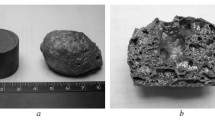The influence of production conditions on the structure, phase composition, and properties of the high-entropy Ti–Cr–Fe–Ni–Cu alloy has been studied. The starting materials were Cr, Fe, Ni, Cu, and Ti powders in the equiatomic ratio. To prepare the starting charge, the powders were mixed and mechanically alloyed in a planetary-ball mill. The compacted billets were hot-forged and then annealed at 1000, 1100, and 1200°C. The phase composition of the hot-forged and annealed alloys is mainly represented by FCC structure. There are few peaks of BCC structures, intermetallides, and titanium. Mechanical synthesis leads to significant distortion of crystalline lattices of all elements in the powder mixture, which is evidenced by substantial broadening of interference lines. The hardness and lattice distortion of the hot-forged samples decrease after annealing with increasing temperature. The materials made of the starting mixtures subjected to preliminary mechanical alloying show higher hardness. The hardness increases with grinding time for both unannealed samples and those annealed at all temperatures concerned.







Similar content being viewed by others
References
S. Ranganathan, “Alloyed pleasures: multimetallic cocktails,” Curr. Sci., 85, No. 10, 1404–1406 (2003).
J.W. Yeh, “High-entropy alloys—a new era of exploitation,” Mater. Sci. Forum, No. 560, 1–9 (2007).
J.W. Yeh, “Recent progress in high-entropy alloys,” Ann. Chim. Sci. Mat., 31, 633–648 (2006).
S.A. Firstov, V.F. Gorban, N.A. Krapivka, and E.P. Pechkovskii, “New class of materials—high-entropy alloys and coatings,” Vest. Tomsk. Gos. Univ., 18, No. 4, 1938–1940 (2013).
L.A. Dreval, P.G. Agraval, and M.A. Turchanin, “High-entropy alloys as materials with multiple base elements,” Visn. Donbas. Derz. Mashynobud. Akad., No. 1 (32), 58–64 (2014).
S.A. Firstov, V.F. Gorban, N.A. Krapivka, et al., “Mechanical properties of cast multicomponent alloys at high temperatures,” Sov. Probl. Fiz. Materialoved., No. 17, 126–139 (2008).
Y.H. Fan, Y.P. Zhang, H.G. Guan, H.M. Suo, and L. He, “AlNiCrFexMo0.2CoCu high entropy alloys prepared by powder metallurgy,” Rare Met. Mater. Eng., 42, No. 6, 1127–1129 (2013).
X.W. Qiu, “Microstructure and properties of AlCrFeNiCoCu high entropy alloy prepared by powder metallurgy,” J. Alloys Compd., 555, 246–249 (2013).
A.I. Yurkova, V.V. Chernyavskii, and V. F. Gorban, “Structure and mechanical properties of high-entropy AlCuNiFeTi and AlCuNiFeCr alloys produced by mechanical activation followed by pressure sintering,” Powder Metall. Met. Ceram., 55, Nos. 3–4, 152–163 (2016).
G.A. Baglyuk, M.V. Marich, A.A. Mamonova, and A.N. Gripachevskii, “Features of structurization during sintering of compacts from a multicomponent Ti–Cr–Fe–Ni–Cu charge,” Powder Metall. Met. Ceram., 54, Nos. 9–10, 543–547 (2016).
S.S. Gorelik, Yu.A. Skakov, and L.N. Rastorguev, X-Ray and Electron Optical Analysis [in Russian], Mosk. Inst. Stali Splavov, Moscow (2002), p. 360.
Ya.S. Umanskii, Yu.A. Skakov, A.N. Ivanov, and L.N. Rastorguev, Crystallography, X-Ray Diffraction, and Electron Microscopy [in Russian], Metallurgiya, Moscow (1982), p. 632.
M.A. Krivoglaz, Theory of Dissipating X-Rays and Thermal Neutrons by Real Crystals [in Russian], Nauka, Moscow (1967), p. 336.
M.A. Krivoglaz, X-Ray and Neutron Diffraction in Imperfect Crystals [in Russian], Nauka, Moscow (1983), p. 408.
Author information
Authors and Affiliations
Corresponding author
Additional information
Translated from Poroshkova Metallurgiya, Vol. 57, Nos. 9–10 (523), pp. 47–57, 2018.
Rights and permissions
About this article
Cite this article
Marych, M., Bagliuk, G., Mamonova, A. et al. The Influence of Synthesis Conditions on the Phase Composition, Structure, and Properties of the High-Entropy Ti–Cr–Fe–Ni–Cu Alloy. Powder Metall Met Ceram 57, 533–541 (2019). https://doi.org/10.1007/s11106-019-00012-z
Received:
Published:
Issue Date:
DOI: https://doi.org/10.1007/s11106-019-00012-z




